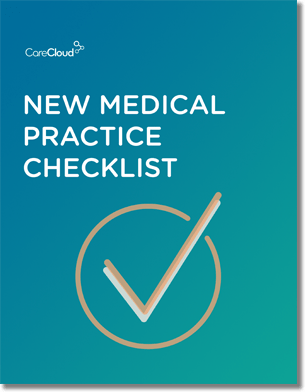Pediatricians often treat something commonly known as growing pains, a term used to categorize the pangs that wake children during sleep during pivotal moments in their physical development.
Growing pains are also felt at thriving practices that are switching to EHRs and having a difficult time coping with the change. Below we explore three different approaches to coping with this pivotal moment in a practice’s development.
Lewin’s Three Phases of Change
Kurt Lewin was a renowned social, organizational and applied psychologist who identified the three stages of change that serve as the basis for many contemporary approaches to change management.
Lewin delineates a seemingly commonsensical need to unfreeze persons from their state of control, so they can be transitioned to a new state, which will then be ‘frozen’ as a new standard of practice. However, undertaking this process is more difficult than it sounds. How do the stages relate to EHR adoption at your practice?
Alternatives to your staff’s state of control can cause discomfort, even if they offer a clear and significant benefit. This is augmented in clinicians, who have been educated to create this kind of steady environment as a coping mechanism when facing the ravishing emotional effects of illness and death.
To unfreeze your staff, you need to compel them to adopt the EHR, and then somehow instill an intrinsic desire for them to continue using it. You should first organize EHR vendor site visits for you and key members of your staff, as well as build a new, very specific set of goals with and for your staff.
Transitions are ongoing and iterative, not just a jump from one state to another. This is particularly true for medical staffs adopting an electronic health record, which requires vendor appraisal, selection, contracts, training and implementation.
So, just like there are multiple steps to understanding the EHR adoption process, there are steps to understanding the journey you and your staff undergo. Keep in mind that your individual journey may not run parallel to the rest of your staff’s, so engaging everyone in the process is critical.
But remind your team that transitions are ongoing, so they don’t become comfortable in a temporary situation where they aren’t yet held accountable for hazards or mistakes arising from learning, using and pursuing a new workflow. Remind them that this is an environment where talk of change can sometimes replace actions.
Lastly, freeze your staff’s new practices and workflows in place. It’s tough to pinpoint where transitions end, however, so this process may be more arduous than expected.
Monitor your staff, remind them the EHR transition is real, that results have been positive and that the future holds even more in store. Ensure your staff there is no turning back, which will help instill a sense of change throughout your practice.”/]
Kubler-Ross Stages of Grief
The emotional cycle in Elizabeth Kubler-Ross’s seminal On Death and Dying has become a widely used mechanism for coping with grief. It isn’t exclusive to dealing with the terminally ill, however. It applies to people negatively affected by the change in general.
What if your staff is being negatively affected by your practice’s EHR transition? These staff members can be undergoing stages of the grief cycle during early EHR discussions, or perhaps even during your go-live. We go further in-depth below.
A staff member may be isolating him/herself from the various stages of the electronic health record project during the planning stage. If one of your staff members shows little interest in learning about the new system and refuses to attend meetings or demos, he/she may be in denial of the change. Intervene by assigning tasks related to the EHR, without necessarily influencing the transition process directly.
One or two staff members may try disrupting the process by demonstrating anger and threatening to leave and take patients with him/her during the implementation stage. Try counseling your staff member – medical director coaching or staff wide anger management classes are useful because they don’t isolate the problematic individual.
What if a staff member makes demands, or uses too many resources, scribes and extra support during training? Inflict peer pressure. Remind the problematic staff member of duties to peers to make him/her constantly behind during the transition, forcing a game of catch-up that’ll assuage the tendency to bargain.
It’s possible for staff members to experience feelings of unavoidability during go-live. Your staff member may use minimum functionality, still rely on paper and handwrite parts of notes. Try training the non-cooperative staff member in private, staging role-playing exercises with mock patients.
During optimization, the opposite of the depression stage may take effect. Your staff member could become overly optimistic about the EHR, finding it more useful than expected and becoming too hardcore a system ambassador. Simply ask him/her to provide reports detailing why the system is so useful, which helps to keep your staff member grounded.
Change Leadership
Dean Anderson and Linda Ackerman Anderson became authorities in the change management field after the publication of Beyond Change Management in 2001.
Among the duo’s management techniques is the Change Leader’s Roadmap, a strategy for authoritative features to manage staff behavior within their organizations follow large-scale infrastructural and/or technological changes.
How does this roadmap relate to EHR transition, you ask? Whether you’re a physician or office manager, staff members at your practice see you as a leader, which makes you equipped to drive change.
Accordingly, promote staff members to leadership positions during the transition based on eagerness and expertise, assess the scope of forthcoming changes and your organizations readiness with them, and create a strategy for the rest of your staff to follow.
As a leader, you should create bold ways to wake your practice up, instilling a need to personally progress within your staff members. Assess what processes you should continue and/or stop to facilitate the goals of your EHR transition and what processes you should put in place to recreate your vision.
Follow the steps below to assure you’re accomplishing your EHR goals in an organized fashion.
Lead the change
Create an organizational vision for your staff
Assess the situation to determine your transition plan and new state
Design your EHR transition process, including new workflows, and new practice state
Analyze the impact of new practice state in conjunction with EHR transition
Plan and organize for implementation of EHR and new practice state
Implement EHR and changes related to your new practice state
Celebrate EHR and new practice state
What kind of change management techniques are you employing at your practice?

Do you know what you need when setting up a new medical practice?



